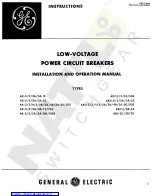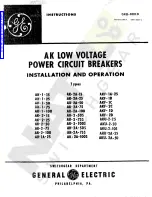
13
40752-195 (1)
Effective 2/2011
The test shall be conducted in accordance with ap-
proved instructions provided with the equipment. A
written record of this test shall be made and shall be
available to the authority having inspection jurisdic-
tion.
7.2 UL Standards Requirements
As a follow-up to the basic performance requirements
stipulated by the N.E.C. as stated above in 7.1, UL Standard
No. 1053 requires that certain minimum instructions must
accompany each ground fault protection system. These
following statements plus a copy of the test record form
breaker.
7.3 General Test Instructions
7.3.1 The interconnected system shall be evaluated in ac-
cordance with the equipment assembler’s detail instruction
7.3.2 The polarity of the neutral sensor connection (if used)
must agree with equipment assembler’s detailed instruc-
tions to avoid improper operations following apparently
correct simulated test operations. Where a question exists,
consult the specifying engineer and/or equipment assem-
bler.
7.3.3 The grounding points of the system shall be veri-
bypass the sensors. High-Voltage testers and resistance
bridges may be used.
THERE IS A HAZARD OF ELECTRICAL SHOCK OR
BURN WHENEVER WORKING IN OR AROUND ELEC-
TRICAL EQUIPMENT. ALWAYS TURN OFF POWER
SUPPLYING BREAKER BEFORE CONDUCTING TESTS.
Note: Since the ground fault circuit breakers derive
their operating power from the phase current, and not
from the neutral current, passing current through the
neutral sensor only will not properly test the ground
fault feature.
7.3.4 Using a low voltage (0-24V), high current, AC source,
apply a test current of 125% of the ground fault pick-up set-
ting through one phase of the circuit breaker, as shown in
Figure 7-1a. This should cause the breaker to trip in less
than 1 second, and if an alarm indicatior is supplied, it
should operate. Reset the breaker and the alarm indicator.
Repeat the test on the other two phases.
7.3.5 If the system is a 4-wire system with a neutral current
sensor, apply the same current as described in paragraph
7.3.4 above through one phase of the breaker, returning
through the neutral sensor, as shown in Figure 7-1b. The
breaker should not trip and the alarm indicator, if sup-
plied, should not operate. Repeat the test on the other two
phases.
7.3.6 If the system is a 3-wire system with no neutral cur-
rent sensor, apply the same current as described in para-
graph 7.3.4 above through any two phases of the breaker,
with the connections exactly shown in Figure 7-1c. the
breaker should not trip, and the alarm indicator, if supplied,
should not operate.
Repeat the test using the other two combinations of break-
er phases.
CAUTION
FIELD TESTING SHOULD BE USED FOR FUNCTIONAL
TESTING AND NOT FIELD CALIBRATION.
ANY TEMPORARY CONNECTION MADE FOR THE
PURPOSE OF CONDUCTING TESTS SHOULD BE
RESTORED TO PROPER OPERATING CONDITIONS
BEFORE RETURNING THE BREAKER TO SERVICE.
7.3.7 The results of the test are to be recorded on the test
form provided with the equipment.
are shipped with each N-Frame ground fault circuit
Содержание Allen-Bradley 140U
Страница 15: ...15 40752 195 1 Effective 2 2011 NOTES...
































